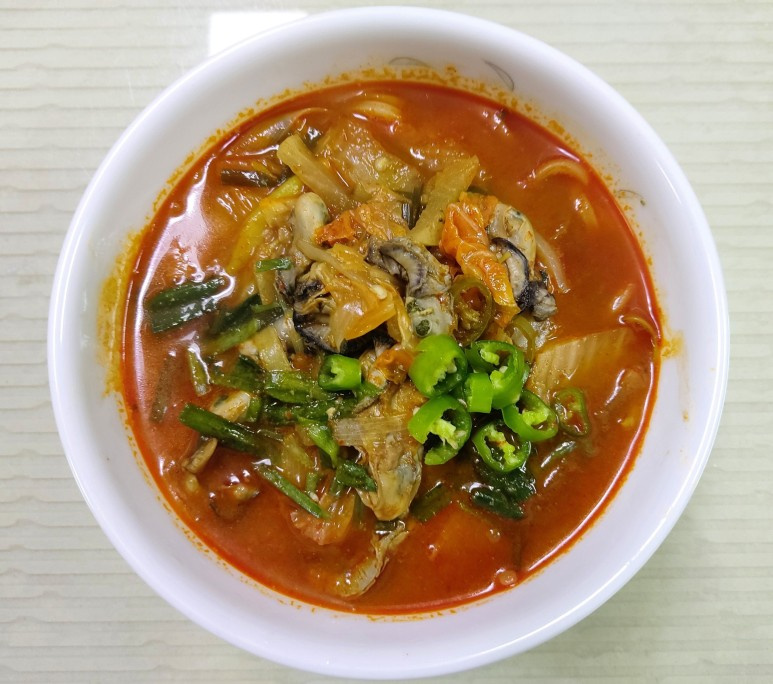Spicy and Refreshing Winter Delight: How to Make Spicy Oyster Jjamppong
Recipe for Spicy Oyster Jjamppong with Deep Flavor from Seasonal Oysters

This winter, I’ve enjoyed a variety of dishes made with fresh seasonal oysters! From oyster pancakes and oyster rice soup to deep-fried oysters, oyster salad, and soft tofu with oysters. I’ve even made a clear oyster jjamppong. Today, however, I’ve prepared a spicy version with a rich, flavorful broth. The soup is invigoratingly spicy and refreshingly savory, making it a perfect dish to enjoy with rice or noodles. Don’t let winter pass without trying this delicious oyster jjamppong!
Main Ingredients- Fresh Oysters: 350g
- Napa Cabbage (Al-baechu): 250g
- Radish (Mu): 150g
- Onion: 1/2 medium
- Scallion (Daepa): 1 stalk
- Cheongyang Peppers (Spicy Korean chili peppers): 2
- Chives (Buchu): 30g
- Shiitake Mushrooms: 2
Seasoning & Broth- Chili Oil: 2 Tbsp
- Gochugaru (Korean chili flakes): 2 Tbsp (heaped)
- Soup Soy Sauce (Guk-ganjang): 1 Tbsp
- Fish Sauce (Aekjeot): 2 Tbsp
- Oyster Sauce: 1 Tbsp
- Salt: 1/3 Tbsp
- Water: 1L
- Beef Bone Broth (Sagal yuksu) or similar stock: 200ml
- Chili Oil: 2 Tbsp
- Gochugaru (Korean chili flakes): 2 Tbsp (heaped)
- Soup Soy Sauce (Guk-ganjang): 1 Tbsp
- Fish Sauce (Aekjeot): 2 Tbsp
- Oyster Sauce: 1 Tbsp
- Salt: 1/3 Tbsp
- Water: 1L
- Beef Bone Broth (Sagal yuksu) or similar stock: 200ml
Cooking Instructions
Step 1
Here is a link to the recipe for clear oyster jjamppong, which pairs wonderfully with this spicy version.

Step 2
Prepare all the ingredients for the jjamppong. If you have baby bok choy (cheonggyechae) or bamboo shoots (juksun), feel free to add them for an even richer texture. (I personally forgot I had frozen bamboo shoots and missed adding them – they add a wonderful crispness to jjamppong!) Today, I’m using chives instead of baby bok choy.

Step 3
Cut the vegetables into bite-sized pieces. Slice the radish into thick, coin-like shapes (about 0.5cm thick). Chop the onion and napa cabbage into large pieces. Cut the scallion lengthwise and broadly. Finely chop the Cheongyang peppers. Thinly slice the shiitake mushrooms.

Step 4
Now, for the sautéing. In a pot, add the large pieces of scallion. Drizzle in 2 Tbsp of chili oil and 1 Tbsp of sesame oil (or perilla oil), and stir-fry over medium-low heat to release their aroma. Once the scallions start to look slightly translucent, add 1 Tbsp of minced garlic and 1 Tbsp of gochugaru (heaped). Sauté until the garlic and scallion are fragrant, being careful not to burn them. This aromatic base is crucial for the jjamppong’s flavor.

Step 5
Once the scallions and garlic are fragrant, add the sliced radish, napa cabbage, and onion. Pour in 1L of water and 200ml of beef bone broth (or your chosen stock). Bring to a simmer over medium heat and cook until the radish and cabbage are tender. Using a stock adds a deeper, richer flavor to the broth.

Step 6
As the vegetables cook and release their juices, season the broth. Add 1 Tbsp of soup soy sauce and 2 Tbsp of fish sauce for the primary seasoning. For extra spiciness and depth, add another 1 Tbsp of gochugaru (heaped). Next, stir in 1 Tbsp of oyster sauce. Taste and adjust the seasoning with salt as needed. (You can add more Cheongyang peppers here if you prefer it spicier.)

Step 7
Finally, add the sliced shiitake mushrooms. (Feel free to add other mushrooms like enoki or king oyster mushrooms according to your preference.) Mushrooms contribute umami to the broth and add a delightful chewiness, enhancing the overall jjamppong experience.

Step 8
Just before turning off the heat, reserve a small portion of chives and Cheongyang peppers for garnishing. Add the remaining chives, chopped Cheongyang peppers, and the cleaned oysters to the pot. Cook for only about 2 minutes. Be careful not to overcook the oysters, as they can become tough.

Step 9
And there you have it – a steaming bowl of deliciously spicy oyster jjamppong, ready to whet your appetite!

Step 10
For the noodles, use pre-cooked Chinese-style jjamppong noodles. If using frozen noodles, boil them in hot water for about 1 minute, then rinse under cold water and drain well. These noodles are often pre-cooked, so a brief dip in hot water is enough to make them chewy and tender.

Step 11
Place the chewy noodles in a serving bowl. Ladle the hot jjamppong broth over the noodles. To ensure the noodles are perfectly heated and infused with flavor, pour the hot broth over them 2-3 times using a ladle. This technique, called ‘toryeom’ (warming/rinsing), helps the noodles absorb the broth beautifully.

Step 12
This rich broth is also fantastic served over rice for a hearty ‘oyster jjamppong bap’ (rice soup).

Step 13
Finally, garnish your spicy oyster jjamppong with the reserved fresh chives and chopped Cheongyang peppers. Enjoy this comforting, spicy, and refreshing bowl of jjamppong before winter ends! It’s the perfect dish to warm you up on a chilly day.



